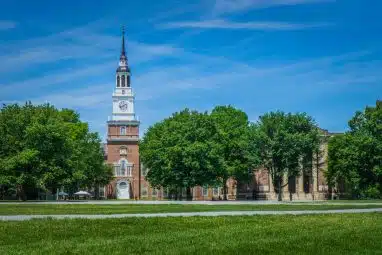When you think of Ivy League schools, prestige, history, and academic rigor come to mind. But what about the worst Ivy League school? Even among these top-tier institutions, there are differences. Some Ivy League schools excel in certain areas, while others fall short in various aspects. This brings us to an interesting question: which is the worst Ivy League school?
Not all Ivies are created equal. According to the 2023 U.S. News & World Report, Dartmouth College had the lowest overall ratings among the Ivy League schools. This was attributed to its smaller endowment, fewer resources, and its rural location in Hanover, New Hampshire. While this doesn’t diminish Dartmouth’s overall quality, it does make it a contender for the bottom of the Ivy League rankings.
- Why Dartmouth Is Considered the Worst Ivy League School
- Criteria for Ranking the Worst Ivy League School
- Other Contenders for the Worst Ivy League School
- What Is the Worst Ivy League School for Specific Programs?
- Ivy League Rankings: Does the “Worst” Even Matter?
- Frequently Asked Questions
- Takeaways
Why Dartmouth Is Considered the Worst Ivy League School
Dartmouth is often considered the “worst” Ivy League school based on several factors. Located in the rural town of Hanover, NH, Dartmouth has the smallest undergraduate enrollment at 4,170 and one of the lowest endowment sizes at $8.1 billion, which may limit the resources available to students compared to other Ivy League institutions.
Its rankings also reflect this perception: Dartmouth ranks lower than most of its peers in major publications, with a U.S. News ranking of 8th (18th overall), a Forbes ranking of 8th (16th overall), and a Wall Street Journal ranking of 8th (49th overall).
Endowment and resources
Dartmouth’s endowment is smaller compared to other Ivy League schools, which impacts the resources available to students. As of 2023, Dartmouth’s endowment was $8.1 billion, which, when spread across its student body, is significantly lower than schools like Princeton or Harvard. This smaller endowment affects the availability of research opportunities, facilities, and financial aid.
Schools with larger endowments can invest more in their students, ensuring better facilities, more support, and richer opportunities. By comparison, Dartmouth’s relatively modest endowment limits its ability to provide these resources at the same level as its Ivy peers.
Location and campus life
Dartmouth’s location in Hanover, New Hampshire, is both a strength and a challenge. The rural setting offers a picturesque and serene environment, but it lacks the vibrancy of an urban setting. For students seeking a more dynamic social experience, Dartmouth’s rural location can be a drawback.
Urban campuses like Columbia’s, located in New York City, provide students with endless opportunities for cultural engagement, internships, and entertainment. Dartmouth’s setting, while beautiful, can feel limiting to students who crave city life and the opportunities it offers.
Criteria for Ranking the Worst Ivy League School
How do you determine the worst Ivy League school? It depends on the metrics you consider. We’ll look at factors such as acceptance rate, endowment per student, student satisfaction, and reputation. All these metrics collectively help shape the public perception and overall ranking of these prestigious institutions.
The table below provides a snapshot of eight prestigious Ivy League universities, detailing their locations, campus settings, undergraduate enrollment, endowment sizes, and rankings from major publications like Forbes, U.S. News, and the Wall Street Journal.
These institutions are spread across urban, suburban, and rural areas, showcasing diverse campus environments. Endowment sizes vary significantly, from $6.5 billion to over $50 billion, reflecting the financial resources available at each university. Ranking placements also fluctuate, with each publication offering different perspectives on academic reputation and student experience.
| Ivy League School | Location (City/State) | Setting | Undergraduate Enrollment | Endowment Size | Forbes Ranking | U.S. News Ranking | Wall Street Journal Ranking |
| Princeton | Princeton, NJ | Suburban | 5,548 | $36 Billion | 1 (1) | 1 (1) | 2 (4) |
| Yale | New Haven, CT | Urban | 6,590 | $41.4 Billion | 2 (2) | 3 (5) | 3 (7) |
| Harvard | Cambridge, MA | Urban | 7,240 | $50.9 Billion | 5 (9) | 2 (3) (tie) | 1 (3) |
| Penn | Philadelphia, PA | Urban | 10,412 | $20.7 Billion | 4 (8) | 4 (6) | 4 (10) |
| Brown | Providence, RI | Urban | 7,125 | $6.5 Billion | 7 (15) | 5 (9) (tie) | 7 (26) |
| Dartmouth | Hanover, NH | Rural | 4,170 | $8.1 Billion | 8 (16) | 8 (18)(tie) | 8 (49) |
| Columbia | New York, NY | Urban | 9,739 | $13.28 Billion | 3 (6) | 6 (12)(tie) | 5 (11) |
| Cornell | Ithaca, NY | Rural | 15,699 | $9.8 Billion | 6 (12) | 7 (12)(tie) | 6 (13) |
Let’s take a closer look at the key metrics:
Location and campus setting
A school’s setting can significantly impact the student experience. Urban campuses like Columbia in New York City offer access to city life, internships, and cultural events, while rural schools like Dartmouth provide a quieter, more close-knit community. The location can shape everything from social life to career opportunities.
Undergraduate enrollment
The number of undergraduates influences the campus atmosphere and class sizes. For example, Dartmouth’s enrollment of 4,170 fosters a smaller, more intimate community, allowing for closer interactions between students and faculty. In contrast, Cornell’s 15,699 students create a more bustling environment, providing a diverse array of social and academic experiences.
Endowment size
Endowment size, which varies greatly among these schools, significantly affects the resources available to students. Schools like Harvard and Princeton, with endowments exceeding $40 billion, can often provide more substantial financial aid, superior facilities, and enhanced research opportunities. In comparison, schools with smaller endowments, such as Brown and Dartmouth, may have limitations in the support and resources they can offer to their students.
Rankings and prestige
Rankings from Forbes, U.S. News, and the Wall Street Journal provide insights into each school’s reputation and perceived value. Higher-ranked schools, like Princeton and Harvard, are often seen as more prestigious, while Dartmouth tends to rank lower, which may influence its perception as the “worst” Ivy. However, each school’s reputation is shaped by various factors, including academic strengths and campus culture, making prestige a matter of perspective.
What makes a school Ivy League?
To understand why we discuss the worst Ivy League school, let’s look at what makes a school Ivy League. The Ivy League is an athletic conference that started in 1954. Over time, the term has evolved to represent more than sports—it symbolizes prestige, academic excellence, and an influential alumni network.
Over the years, the term has come to symbolize prestigious education, a powerful alumni network, and exceptional research facilities. The eight Ivy League schools are Harvard, Yale, Princeton, Columbia, Brown, Dartmouth, Cornell, and the University of Pennsylvania. These schools are known for their exclusivity and high standards.
They all share exclusivity, top-notch education, and a unique history. But that doesn’t mean they’re all equal in quality or student experience. Some are stronger in specific fields, while others are more well-rounded. Each school has distinct qualities, but this doesn’t mean one can’t be considered the “worst” among them.
Other Contenders for the Worst Ivy League School
While Dartmouth frequently ranks at the bottom, Cornell and Brown are also contenders. Each of these schools has its own challenges and unique characteristics, which can affect their ranking.
Cornell University
Cornell has the highest acceptance rate among the Ivy League schools at 8.7%. This makes it less exclusive compared to its peers, which can influence its perceived prestige. Cornell’s large student body and rigorous workload also contribute to lower student satisfaction scores.
Cornell’s endowment per student is lower compared to schools like Princeton, which affects the quality of resources it can offer. Despite these challenges, Cornell has a strong reputation in specific programs, such as engineering and hotel management, which makes it a top choice for many students.
Brown University
Brown’s Open Curriculum is seen as both a strength and a weakness. It gives students the freedom to explore their interests, but some critics argue that it lacks the structure that certain students need to succeed. According to The Brown Daily Herald, this lack of structure may undermine student solidarity, potentially intensifying issues of income inequality and elitism on campus. Additionally, Brown’s smaller endowment compared to other Ivies can limit the resources available to students.
For some students, Brown’s academic freedom is a perfect fit, but for others, the lack of guidance can be overwhelming. Brown’s unique approach appeals to those who value independence in their education, but it may not suit everyone.
What Is the Worst Ivy League School for Specific Programs?
Another way to determine the worst Ivy League school is to look at specific academic programs. For example, Dartmouth’s Tuck School of Business doesn’t have the same level of global recognition as UPenn’s Wharton School, which can make Dartmouth a less attractive choice for students specifically interested in business.
In engineering, Cornell is often considered the strongest Ivy, while Yale is less known for its engineering programs. Depending on your area of interest, your perception of the “worst” Ivy may change. For arts and humanities, Harvard, Yale, and Princeton dominate, while schools like Cornell and Dartmouth may not have the same level of prestige.
Ivy League Rankings: Does the “Worst” Even Matter?
Deciding which Ivy League school is the “worst” is a subjective task, often depending on what you prioritize in a college experience. Whether it’s academic reputation, campus culture, or specific programs, each Ivy has unique strengths that cater to different student preferences. While some rank Harvard, Princeton, and Yale at the top, with Dartmouth often at the bottom, this doesn’t mean Dartmouth lacks value.
The gap between the “best” and “worst” Ivy League schools is minimal compared to the difference between Ivy and non-Ivy institutions. Dartmouth, Brown, and Cornell offer world-class education and resources. Each Ivy has standout programs, like Cornell’s School of Hotel Administration, that could make it the perfect choice for certain students regardless of overall rankings.
Ultimately, whether a school is ranked “worst” or “best” depends on what you value most. Focusing on factors like campus setting, specific academic strengths, or alumni networks can guide you toward the right fit. No matter the rankings, each Ivy League school offers exceptional opportunities, and the “worst” one might just be where you thrive.
Frequently Asked Questions
1. Which Ivy League school is the hardest to get into?
Harvard University is often considered the hardest to get into. For the class of 2028, its acceptance rate was 3.2%, the lowest among all Ivy League schools.
2. What is the worst Ivy League school in terms of student satisfaction?
Dartmouth College is often ranked lower in terms of student satisfaction, largely due to its rural location and smaller campus, which can lead to feelings of isolation.
3. Are Ivy League schools worth the hype?
Ivy League schools offer exceptional opportunities, but whether they are worth it depends on individual goals and preferences. Although they are prestigious, they are not the right fit for everyone.
4. Which Ivy League school has the lowest endowment?
Brown University has a smaller endowment than other Ivy League schools, which can affect the resources available to students.
5. Do Ivy League schools guarantee success?
No, attending an Ivy League school does not guarantee success. Success depends on various factors, including individual effort, networking, and career choices.
Takeaways
- The “worst” Ivy League school depends on factors like student satisfaction, endowment, and exclusivity.
- Dartmouth is often considered the “worst” due to its smaller endowment, rural location, and lower student satisfaction.
- Cornell faces challenges such as a high acceptance rate and lower student satisfaction, while Brown’s open curriculum can be seen as lacking structure, affecting its ranking.
- Choosing the right school depends on personal preferences, goals, and the fit for your specific needs.
- Consult an admissions expert to help you evaluate your personal goals and guide you in choosing the best college for you.




